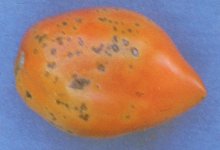Alternaria blight
Scientific name:
Alternaria spp.
Causal organism: Fungus
Important species:
Alternaria leaf spot on tomato; Alternaria stem canker (A. alternata)
Alternaria leaf spot on cole crops; Alternaria blight (A. brassica; A. brassicicola)
Leaf blight of carrot; Black rot of carrot (A. dauci; A. radicina)
Host plants
Crucifers, tomato, carrots, beans are the most susceptible crops but will also infect other herbaceous plants
Affected plant stages
All plant growth stages
Affected plant parts
Whole plant
Symptoms
Alternaria fungus is transmitted through seeds (seedborne). The fungi
colonize the seed coat during the seed development stage and when the seed germinates, they become active. The fungal disease causes
damping-off and
stunted seedling. Infection develops so slowly that a symptom only appears when the seedlings are transplanted in the field. The leaf spots vary in sizes from very tiny spots up to 5 cm in diameter. The spots begin as small yellow or brown spots that slowly enlarge to about 5 cm in diameter, dark colored spots with
concentric rings. When all the spots join together, the leaves will turn yellowish or blackish and drop off.
Alternaria leaf spot on tomato
 Photo source: Texas A&M University
Photo source: Texas A&M University
Alternaria stem
canker (lesion) on tomato appears on stems, leaves, and fruit. An infested stem near the soil line has dark-brown to black cankers with concentric rings. When the lesions enlarge, they girdle the stem and eventually kill the plant.
Fruits that are harvested from infested plants have brown or black
necrotic sunken (submerged) lesions.
Alternaria leaf spot on cole crops
On cabbage, the initial symptom appears as small dark-brown to black or sooty-black spots on the leaves. The infection becomes evident as the spot becomes bigger because it has a darker center than the rest of the lesion. When all the spots meet, the leaves will turn yellow and die. Infected cauliflower and broccoli heads have brown to black spots on florets (small flowers), seed stalks, and seedpods that makes them unmarketable.
Leaf blight of carrot; Black rot of carrot
Infected carrot seeds will fail to germinate and infected seedlings die after emergence, having
the damping-off symptom. The infected leaf and leafstalk have dark-brown to black spots with yellow edges. As the spots get bigger and merge, the whole leaf becomes blackish causing the whole top to wilt. The loss of leaves causes poor growth and small carrots. Infested
taproot is surrounded by patches of black rots.
Conditions that favor development
- Infected seeds and transplanting materials
- Presence of alternate hosts like weeds
- Infected plant debris that are left in the field to rot
- Cool and wet weather conditions with high relative humidity
Preventive control
- Proper seed selection and
warm seed treatment
- Remove and destroy infected leaves but do not put them on the compost pile
- Staking tomatoes provides air flow among plants
- Practice wider spacing between plants' hills and rows to have higher light penetration and air flow
- Remove tall weeds around the plants to increase air movement and lower humidity levels
- Onion exract

